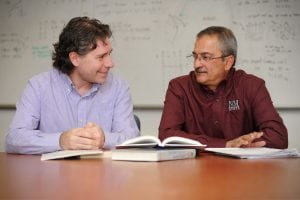The grant will expand this research to include scientists across the state.
The National Science Foundation recently announced the five-year grant for New Mexico’s SMART Grid Center under its Established Program to Stimulate Competitive Research (EPSCoR). The research program seeks to transform existing electricity distribution feeders into interconnected microgrids and will utilize multiple testbeds across New Mexico.
NMSU will receive $7.3 million of the EPSCoR grant.
“I’m super excited about this,” said Enrico Pontelli, NMSU Dean of the College of Arts and Sciences, who partnered with the College of Engineering to initiate smart grid research at NMSU in 2014 with a $5 million award from the NSF’s Center for Research Excellence in Science and Technology (CREST). “We are very passionate about research in this area. Five years of funding to expand this research at the state level is fantastic.”
The NSF EPSCoR Research Infrastructure Improvement (RII) Track 1 grant will link researchers and students from NMSU, the University of New Mexico, New Mexico Tech and Santa Fe Community College with researchers and scientists at Sandia Laboratories and Los Alamos National Laboratory, as well as other organizations in New Mexico such as the Microgrid Systems Laboratory and Explora Museum.
“The NM SMART Grid Center is a novel, interdisciplinary research center that will address pressing design, operational, data and security challenges of next-generation electric power management,” said William Michener, principal investigator for the award and state director of New Mexico EPSCoR. “Through this grant, we will not only advance research areas of national importance, but train a cadre of undergraduate and graduate students in New Mexico to join the STEM workforce.”
New Mexico is one of seven jurisdictions to receive one of these awards this year.
“We are very proud because this award is the result of a nice collaboration that involved the three research institutions in the state,” said Pontelli. “We worked together with the state director of the EPSCoR office and we built the proposal as a collaboration where we all come together and everything is integrated.”
EPSCoR is a program designed to fulfill the NSF’s mandate to promote scientific progress nationwide. Through this program NSF establishes regional partnerships with government, higher education and industry to develop research and development capacity.
“Our goal is to work together to build the research basis for the technology for the future electric grid,” Pontelli said. “New Mexico is the perfect state for this because we have access to any kind of energy source you can think of. We have access to oil and gas, we have access to wind, we have access to sun. We have everything in the entire spectrum and at the same time we have very diverse land configuration – we have mountains, we have desert. We have different types and sizes of communities. We need to cover all the aspects and meet the needs of the state.”
Part of the research includes cyber security along with research about the directional relationship between power plants and customers to predict when customers need electricity to create cheaper, sustainable energy use.
While training students and developing research will build up the infrastructure for smart grid technology, ultimately, the objective would be to work with New Mexico’s electric suppliers to translate the research into practice and take the technology statewide.
For Pontelli, the strength of the project is its integrated collaboration.
“Every university provides expertise for this project,” Pontelli said. “We organized the research in four objectives and for each one, we have researchers from the entire state. There was no single institution that could achieve the objectives alone. We come together, work together and we strengthen the state.
“My goal is if anyone wants to talk about research in smart grids they come to us,” Pontelli said. “We want to be the national leaders in smart grid technology.”

